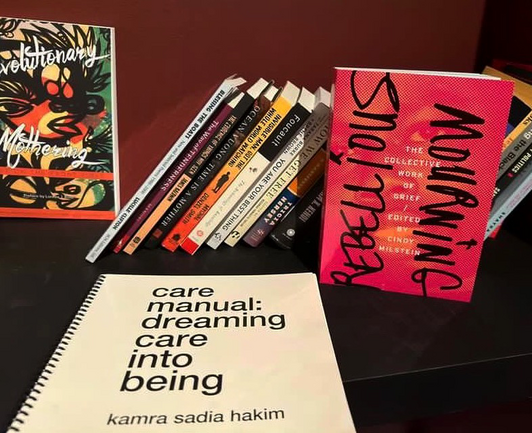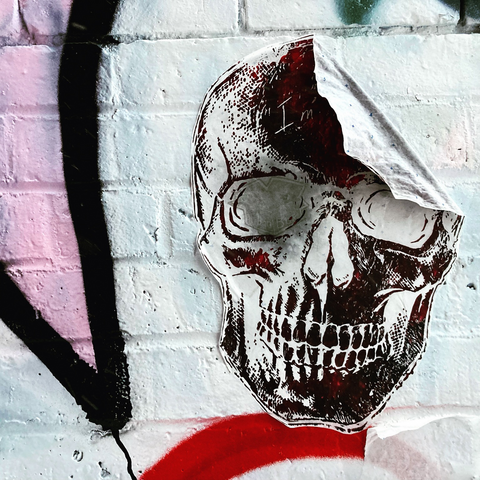Cindy Milstein · @cbmilstein
2298 followers · 377 posts · Server kolektiva.socialThere were so many sweet, tender, and moving moments at this past weekend’s @ACABookfaire—not to mention silly, inspiring, and connective ones (like the best and most wholesome kind of anarchist family reunions), among so many other dreamy descriptors—that it’s hard to narrow down examples, much less narrow down my gratitude to the organizers, tablers, presenters, and really everyone who converged at this bookfair.
But a highlight for me was the beautiful space made for not only honoring but also remembering and being vulnerably real about our grief—that is, sharing the whole of ourselves and life, with its abundance of joys and sorrows, wins and losses. There were three workshops related to mourning, ritual, dying, and death. There was an altar specifically built for the bookfair by an anarchist gravedigger and casket maker, and people added flowers, notes, art, photos, and herbal grief potions to it over the three days (see pictures 3 and 4).
And there was the friend from Durham, NC, who brought the banner pictured here, which they entrusted to me on the sixth anniversary of Charlottesville on August 12, and which @firestormcoop then let me hang in a prominent place of visibility and honor—over the area in the bookstore used for speakers during the bookfair. Six years ago, the banner was painted soon after Heather Heyer was murdered, and so many others were deeply injured and forever scarred, by fascists during the Unite the Right rally in Cville. It then was originally hung from the stone base of the first Confederate monument that folks tore down in NC, and later, on the one-year anniversary of that monument falling, it was hung up again—this time as part of an altar with names and flowers and candies around it, and folks read the names of people killed by the police in Durham.
The banner now has a home at Firestorm, as daily reminder that “we struggle in memory of all we’ve lost to white supremacy and fascism.” To my mind, all anarchist spaces should routinely make such room for the #ArtOfRemembrance, #RebelliousMourning, and #MendingTheWorld—which is about mending our own rebel hearts too.
#artofremembrance #RebelliousMourning #mendingtheworld
Cindy Milstein · @cbmilstein
2204 followers · 330 posts · Server kolektiva.socialYou can judge a book by its cover.
Or at least that’s true of my dear friend @eff_charm’s designs, such as the one pictured here for my edited anthology Rebellious Mourning: The Collective Work of Grief (@akpressdistro).
His book designs, exterior and interior, are more than just strikingly powerful works of art—though they are that too, as I was reminded recently when @tigerbeat kindly shared photos with me of #RebelliousMourning in the @jewseum, accompanying an exhibition by @cara_levine titled “To Survive I Need You to Survive.” The anthology’s cover here sits aesthetically side by side in a museum a pleasing arrangement with another book, @thisisnotagun, with the bright pink and orange seeming to shout “joy” and “life” and “defiant resistance” against the starkness of all the unnecessary death and loss perpetrated by the current social order. In this case for both books, they share in the rage and sorrow over murder by cop. For if you look closely at @eff_charm’s design, you’ll see the face of David Ware, who was killed on January 23, 2007 by law enforcement agents in Ypsilanti, Michigan.
Hence why you can judge Rebellious Mourning by its cover (and interior) design: @eff_charm as a collaborator and accomplice par excellence draws out what the many bravely vulnerable, poetic, bittersweet stories in this collection can’t fully say on their own. When we tell our stories, doing the work of grieving collectively all that we shouldn’t be made to mourn, words help to honor and make bearable our losses, yet words are and will never be enough. Our hearts hold a world of emotions that we feel, that move through all of our senses.
This cover design acts in concert with the book’s compelling, tear-inducing yet cathartic stories to allow us to do that feeling and seeing, visually and somatically, calling forth presence despite absence, life despite (or because of death). The design “reads” emotionally, urging us to see our survival as intimately connected to the survival of each other and the nonhuman ecosystems of which we’re a part. Urging us to mourn rebelliously in service of love, care, and all that’s liberatory in these grievously horrific times.
Cindy Milstein · @cbmilstein
2197 followers · 328 posts · Server kolektiva.socialSneak peek of a banner—featuring two purple+black roses—that I’m so honored to be painting today alongside a new, big-hearted friend for the “espace de deuil” (grief space) to be set up outside the Montreal Anarchist Bookfair this whole weekend.
Cindy Milstein · @cbmilstein
2173 followers · 286 posts · Server kolektiva.socialGrief lands us in unexpected places. And it’s how we create collective room for processing it that allows us to journey through our grief in ways that make it more bearable, especially related to unnecessary losses.
Yet it still felt surprising to see my edited anthology “Rebellious Mourning: The Collective Work of Grief” (@AKPress, with poignant design by @eff_charm, including cover art honoring David Ware, a Black man murdered on January 23, 2007, by police in Ypsilanti, Michigan) in a literal room in a museum—a respite room, to be exact.
The term “respite” refers to offering temporary care in the form of a period of rest and relief. Meaning it’s only an interval in the grinding violence of, in this case, anti-Black racism.
Such respite feels crucial in the context of this museum exhibition, “An Archaeology of Silence,” being held now at the @deyoungmuseum. The exhibit is described thusly: “Artist Kehinde Wiley’s new body of paintings and sculptures confronts the silence surrounding systemic violence against Black people through the visual language of the fallen figure. … [Deaths] are transformed into a powerful elegy of resistance. The resulting paintings of figures struck down, wounded, or dead, referencing iconic paintings of mythical heroes, martyrs, and saints, offer a haunting meditation on the legacies of colonialism and systemic racism.”
Mourning and honoring the systemic loss of Black life should include some comfort, some relief. But how could this not be temporary given the lengthy, genocidal history of anti-Blackness along with the ongoing brutality of white supremacy, policing and prison systems, and increasingly outright fascism?
The choice of “respite” for a room filled with grief-related books and, I imagine, some breathing space from the heaviness of this exhibition feels appropriate: there can be no real, sustained relief in this world. How we mourn, though, has an intimate, inseparable relation to how we go about fighting for social transformation—or it should. Our ancestors, so many of them still existing as “unquiet ghosts” far from being at peace, demand no less.
#RebelliousMourning
#NoMoreStolenLives
#CollectiveWorkOfGrief
https://www.akpress.org/rebellious-mourning.html
(Thanks to Steve Rhodes for sending me this photo)
#RebelliousMourning #nomorestolenlives #collectiveworkofgrief
Cindy Milstein · @cbmilstein
2139 followers · 277 posts · Server kolektiva.social“How’s your covid grief these days?”
Those words, which traveled across an ocean and many borders as a DM, supplied a recognition that’s too rare in this so-called post-pandemic world: someone else feels stuck in mourning.
For without collective reckoning of what humanity has gone and is still going through …
Without collective processing of the innumerable losses as our sacred shared duty …
Without public do-it-ourselves altars, memorials, and other pandemic grief spaces woven into the public landscape, acknowledging the immensity of the collective and individual trauma and myriad absences …
Without honoring our dead and actively fighting for the living …
Without collective care for those who are sick, disabled, grappling with long covid, or dying …
Without people routinely inquiring into each other’s losses in this world where there’s so much to mourn and grieving demands its own good, communal time …
Without masks and other visible gestures of everyday forms of looking out for the well-being of all …
Without regard for how some people are being cut off from living fully and in community because they are at risk while so much of social and work life is “back to normal” …
Without those in our own anarchist(ic) circles steadfastly, reciprocally, and without question always including and lovingly abiding by covid and other harm reduction as practices in all our spaces …
How can one not be stuck?
How can one not feel dead inside? A hollow shell? Alone?
Grieving needs the company of others, not merely to hold the profundity of any loss and make it more bearable, but to witness, believe, and remember the loss, and thus integrate it into how we want to move forward.
Without that, especially in the face of the human-made catastrophe of a global pandemic, most of humanity has shifted backward into a delusional normal that denies both death and qualitative life, thereby ensuring the hum of a murderous social system.
A few, too few, take time to ask each other and really listen to the reply, “How’s your grief?”
With that small act, mourning rebelliously finds some ground from which to mend this world.
#CollectiveCare
#RebelliousMourning
#CollectiveWorkOfGrief
(photo: black-and-white etching-style image of skull wheat pasted on a white-painted brick wall, with the edge of the forehead peeling off a bit, as seen in Tio’tia:ke/Montreal, winter 2023)
#CollectiveCare #RebelliousMourning #collectiveworkofgrief
Cindy Milstein · @cbmilstein
2015 followers · 223 posts · Server kolektiva.socialGrief rituals, one could argue, are part of the essential grounding for millennia-old cultures that orient toward far more ecological relations with the whole of this earth, including each other. For loss is part of the seasons of life, which ancient—and yet still here—cultures recognize needs to be honored through ceremony so as to remember what is loved and cherished, and continually reaffirm a duty to love and defend life.
It is little wonder that as colonialism and capitalism, heteropatriarchy and white Christian supremacy, grew into hegemonic death machines over the centuries, they tried to kill off innumerable life-giving rituals and ceremonies that humans passed along over generations to hold each other through transitions. They tried to make people forget that minds and bodies crave—and need—those rituals and ceremonies in order to sustain hearts and spirit. And without heart and spirit, humans become shells of themselves.
It is little wonder, then, that so many humans today, but especially human-made institutions like states and their police, are so hollowed out of heart—of empathy and sociability, solidarity and communal care—they all too easily acquiesce to or participate in killing off life.
It has been a week since Tortuguita was murdered in cold blood by cops within Weelaunee forest, where Tort gave full heart and loving spirit to defending life-giving ecosystems. May their memory be a blessing.
In that week, so many people have, in essence, “sat shiva,” a ritual within Jewishness that is about taking seven days to be with community (whether people or trees) to begin to honor and process loss of a beloved and grief at their murder. Shiva doesn’t mean doing nothing. It is a time to sustain our hearts and spirits.
So it’s remarkable—a testament to Tort as well as the big, amorphous, autonomous, yet interwoven circles of rebels—that this past week has witnessed an outpouring of remembrance that we do indeed need and can revive ancient grief rituals, as precisely the ground that allows us to keep fighting, not merely to #StopCopCity, but to stop all systemic theft of lands and life.
#RebelliousMourning
#MourningOurDead
#FightingLikeHellForTheLiving
#RitualAsResistance
#MendingTheWorld
(photo: sign with words “Weelaunee People’s Park” seen among the trees in October 2022 at @defendATLforest)
#StopCopCity #RebelliousMourning #MourningOurDead #fightinglikehellfortheliving #RitualAsResistance #mendingtheworld
Cindy Milstein · @cbmilstein
2002 followers · 217 posts · Server kolektiva.socialSunday afternoon #FuckThePolice (and their allies) stroll amid signs of fresh snowfall and the fresh fallout of what allegedly was a #StopCopCity vigil for late last evening on the stolen Anishinabeeg lands of so-called Lansing, Michigan.
#MourningOurDead
#RestInPowerTort
#RebelliousMourning
#FightingLikeHellForTheLiving
#ForestsNotFascism
@defendATLforest
@stopcopcity
Atlanta Solidarity Fund
#fuckthepolice #StopCopCity #MourningOurDead #restinpowertort #RebelliousMourning #fightinglikehellfortheliving #forestsnotfascism
Cindy Milstein · @cbmilstein
1167 followers · 92 posts · Server kolektiva.social(Part 4 of 6): By way of celebrating my new book “Try Anarchism for Life” being in print and out in the world, and because I have a backlog of photos of circle As in the wild, plus to honor and thank the folks who took the time and care to write blurbs for this book, here’s a trifecta of what I hope are some beautiful expressions of anarchism: street art + the book’s cover + a blurb.
I’ve been thinking a lot—or more than I already do—about “tipping points, when phenomena palpably shift from bad to worse—such as, to my queer Jewish anarchist mind, proto-fascism tipping to fascism after the US midterms—and how those of us who are anarchists see train wrecks coming long before the train has even left the station and beautifully prepare all sorts of infrastructures of #Solidarity way ahead of time. Infrastructures of #MutualAid, #CommunitySelfDefense, #RebelliousMourning, and #FierceLove. It’s shattering my heart that we must increasingly use those infrastructures *merely* to try to lessen the genocidal impacts of Christian fascism here. Yet they are also, always, gesturing toward #AWorldWithoutFascism.
“‘Try Anarchism for Life’ is both a beautiful homage to the countless fragments of ephemeral resistance that constitute everyday antiauthoritarianism and a principled call to commit to stitching together those fragments of daily autonomy-making into flourishing lives of resistance. Paired with unique renditions of the classic circle A, Milstein’s poetic phrases endow age-old concepts like mutual aid and solidarity with renewed vitality and urgency.”
—Mark Bray, author of “Antifa,” “The Anarchist Inquisition,” and “Translating Anarchy”
Copies of the book are available from the publisher, @tangledwild, at www.tangledwilderness.org (for folks in and outside of the US too), @akpressdistro at www.akpress.org, or your favorite anarchist(ic) bookstore, and libraries.
(photos: the rock-solid strength of our circles, as portrayed on a sticker seen in mid-Oct at @defendatlantaforest; beautiful book cover, designed by @eff_charm with circle A by @landonsheely)
#TryAnarchismForLife
#TheBeautyOfOurCircle
#AnarchismOrFascism
#FuckFascism #FTP
#WeAreAllWeNeed
🖤💖🌿
#solidarity #MutualAid #communityselfdefense #RebelliousMourning #fiercelove #aworldwithoutfascism #TryAnarchismForLife #TheBeautyOfOurCircle #anarchismorfascism #fuckfascism #ftp #WeAreAllWeNeed







